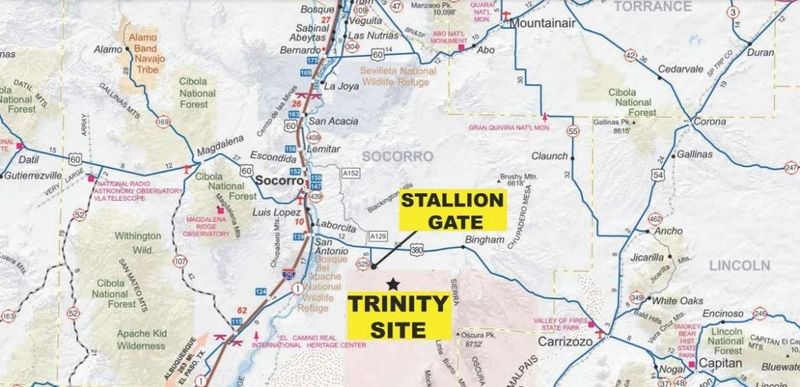This article is the fourth in a series by White Sands Missile Range Public Affairs Office that will delve into the history of the Trinity Site Test, which marked its 80th anniversary on July 16, and the commemoration of the growth and evolution of White Sands Missile Range, which marked its 80th anniversary on July 9.
An observance for White Sands Missile Range will take place on Oct. 17 at WSMR, and a commemoration for Trinity Site will take place Oct. 18 at the Trinity Site Open House.

Evolution of White Sands Missile Range — a continuing series
White Sands Missile Range played a significant role in the development and testing of air defense systems, particularly during the Cold War era. Early efforts focused on adapting captured German V-2 rockets and developing new missile systems like the Nike. Later, WSMR became a key location for testing surface-to-air missiles and other advanced air defense technologies.
Early development:
Following World War II, WSMR, then known as White Sands Proving Ground, was established to test captured German V-2 rockets and develop new missile technology.
Nike Program:
The Nike program, which included the development of the Nike Ajax and Nike Hercules missiles, was a major focus at WSMR. These were among the first supersonic, anti-aircraft guided missiles designed to intercept enemy aircraft.
Talos Defense Unit:
In the mid-1950s, a prototype land-based Talos air defense system was constructed at WSMR’s Talos Defense Unit (TDU), based on the Navy’s ship-borne Talos missile. The TDU was a key site for testing and evaluating this system.
Desert Ship:
The Navy’s “Desert Ship” (LLS-1), a landlocked facility designed to simulate shipboard missile launch conditions, was used for testing the Talos missile and other naval weapon systems.
Patriot and Other Systems:
WSMR continued to be a vital location for testing advanced air defense systems like the Patriot missile system, including its PAC-3 variant.
Ongoing Mission:
Today, WSMR continues to support defense and space exploration programs, including the testing of advanced air defense technologies. The range’s history reflects the evolution of air defense capabilities from early rocket technology to the sophisticated missile systems of today.
White Sands Test Center Commander Col. Matthew Johnson talked about the future of air defense at WSMR.
Johnson said the WSMR workforce has contributed to the air defense program significantly.
“I am super impressed with the professionalism and technical expertise of the workforce as it relates to testing the Army’s future air and missile defense systems,” Johnson said. “The quantity and quality of knowledge that the team has is extremely helpful to ensure successful test execution and providing future capability to our soldiers.”
Johnson said that over the last year he has seen the future of air and missile defense being tested here. Despite some challenges with scheduling or problems with the systems, which are expected during tests, the team is there to dive in and help.
“As you look at the future of air and missile defense, I’m confident that we’ve got the right people here that are going to help the Army get to where it wants to go in the future. People are definitely our biggest contribution.”
Looking to the future, Johnson said WSMR has a significant role in air and missile defense for the Army.
“The character of war is starting to include drone strikes, and hypersonics being one of the more prevalent capabilities that will need a large missile range for testing,” Johnson said. “I like to call WSMR the catcher’s mitt, as it relates to air and missile defense, range artillery or hypersonics.”
“We have an amazing piece of geographic real estate in southern New Mexico that allows us to execute long range fires, air and missile defense testing over a large swath of land so we can test our nation’s future systems, while at the same time being able to gather critical data information to inform the development of those systems.”
He said hypersonics is a future capability that the military is looking to provide, and White Sands is going to play an extremely significant role in the testing of hypersonics capabilities as those continue to develop and mature in the coming years.
On Oct. 17, the commemoration will connect the history of America’s Range with its future testing efforts. The day will feature a ceremony, opportunities to interview subject-matter experts from White Sands Missile Range, a tour of the historical site at Launch Complex 32, and a visit to the museum.
Events begin at 10:30 a.m. and will conclude before 5 p.m. Guests for this event are encouraged to come through the Las Cruces Gate. It is located south of Highway 70 on Route 213.
Trinity Site Open House
The Trinity Site Open House is scheduled for Saturday, Oct. 18, at 10 a.m. Entrance to the site will be through Stallion Gate off of Highway 380. Stallion gate is open at 8 a.m. and closes at 2 p.m.
Visitors can take a quarter mile walk to Ground Zero, marked by a small obelisk indicating the exact spot where the test took place.
The Los Alamos National Lab’s Bradbury Museum is bringing in their mobile exhibit to underscore the significance of what occurred at Trinity Site in 1945 and how it connects to our nation’s global security mission as well as the spectrum of ancillary science from health physics, nanotechnology, and supercomputing to earth science, biofuels, and space exploration.
Weather and road conditions permitting, the Schmidt/McDonald Ranch House will also be available for visitors. This ranch house is where the scientists assembled the plutonium core of the bomb.
The open house is free. To reach the Trinity Site, visitors should enter White Sands Missile Range through the Stallion Range Gate, located five miles south of U.S. Highway 380. The turnoff is 12 miles east of San Antonio, New Mexico.
White Sands Missile Range, DoD’s largest, fully-instrumented, open air range, provides America’s Armed Forces, allies, partners, and defense technology innovators with the world’s premiere research, development, test, evaluation, experimentation, and training facilities to ensure our nation’s defense readiness.
Miriam Rodriguez, White Sands Missile Range Public Affairs.
This article originally appeared on El Paso Times: White Sands Missile Range: Air Defense at WSMR
Reporting by Miriam Rodriguez / El Paso Times
USA TODAY Network via Reuters Connect


